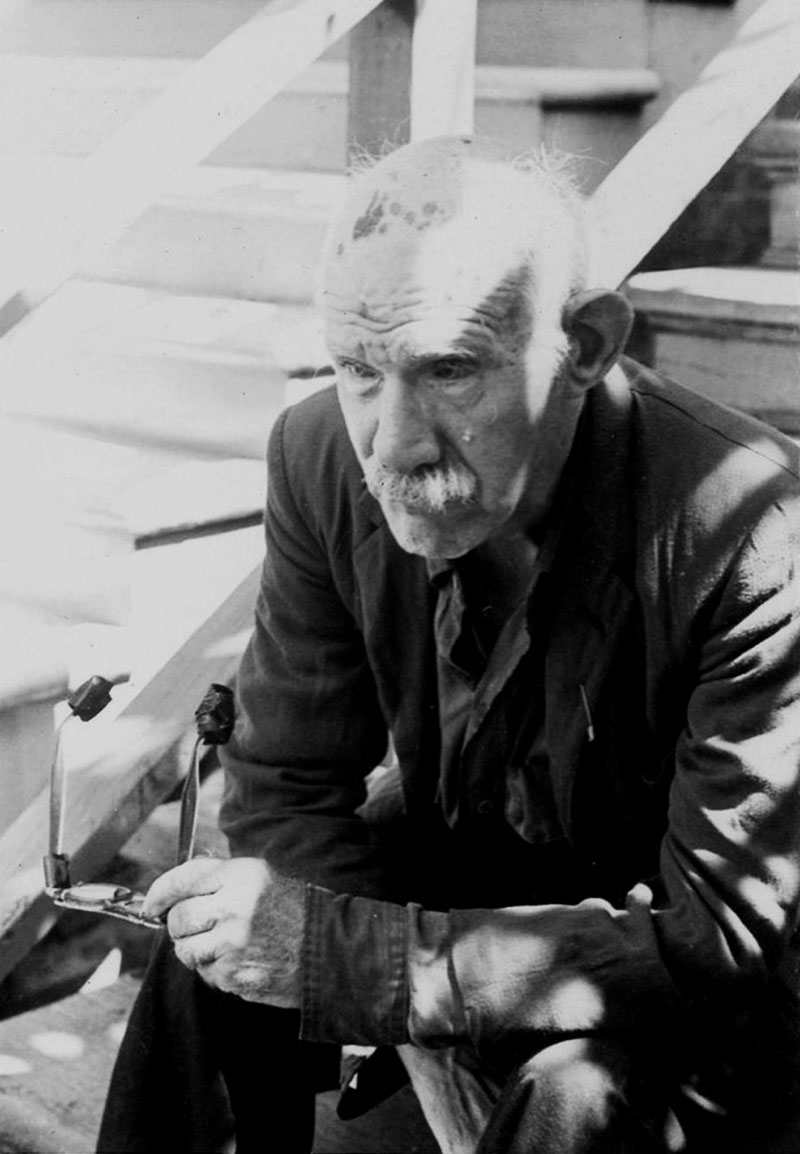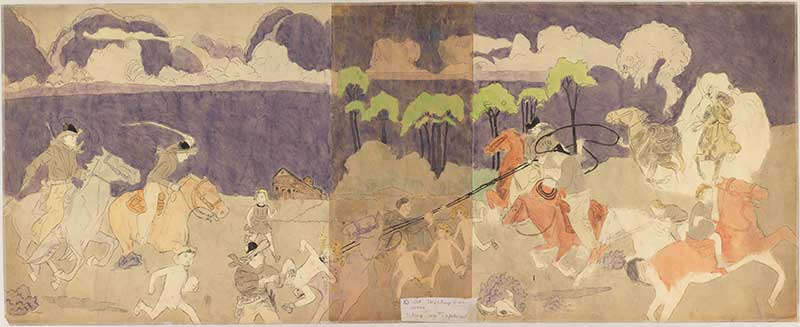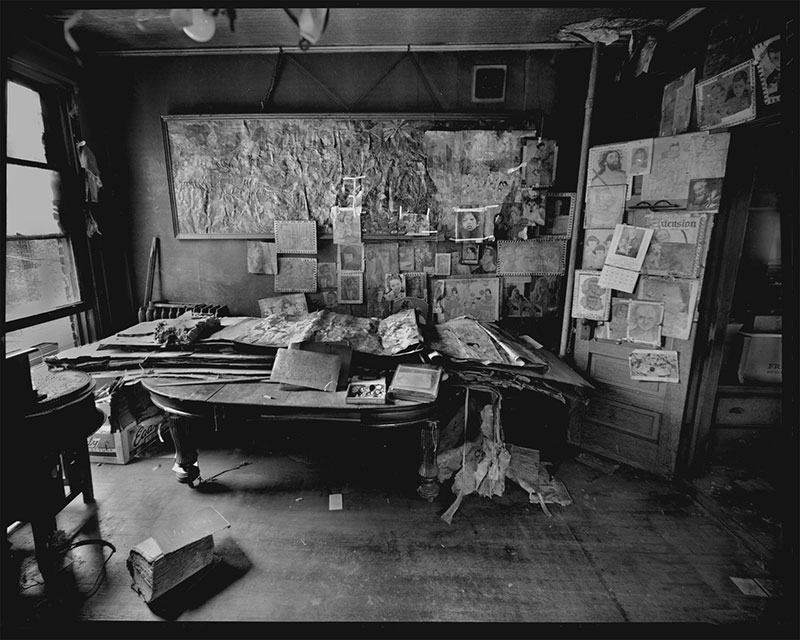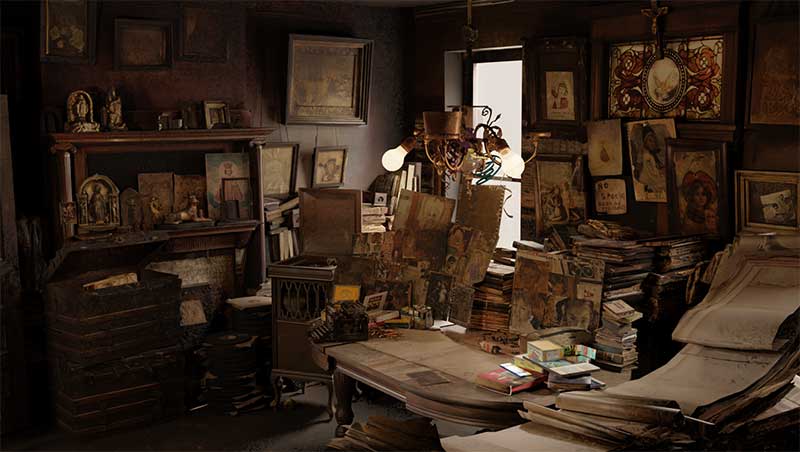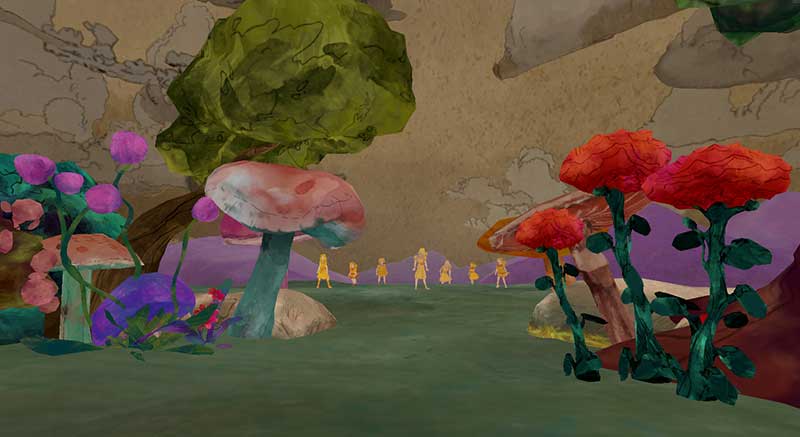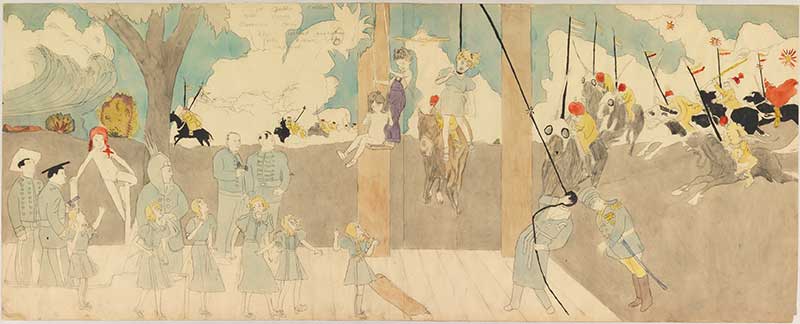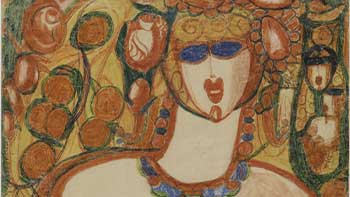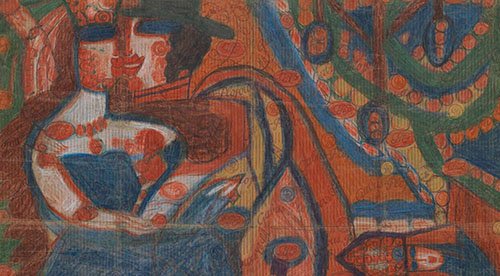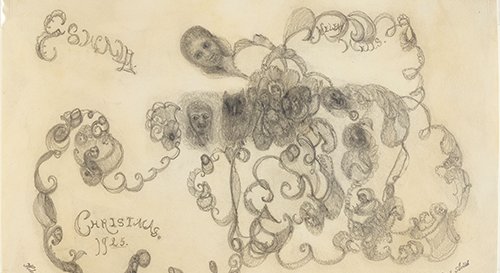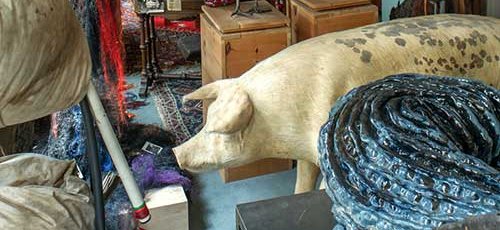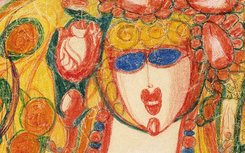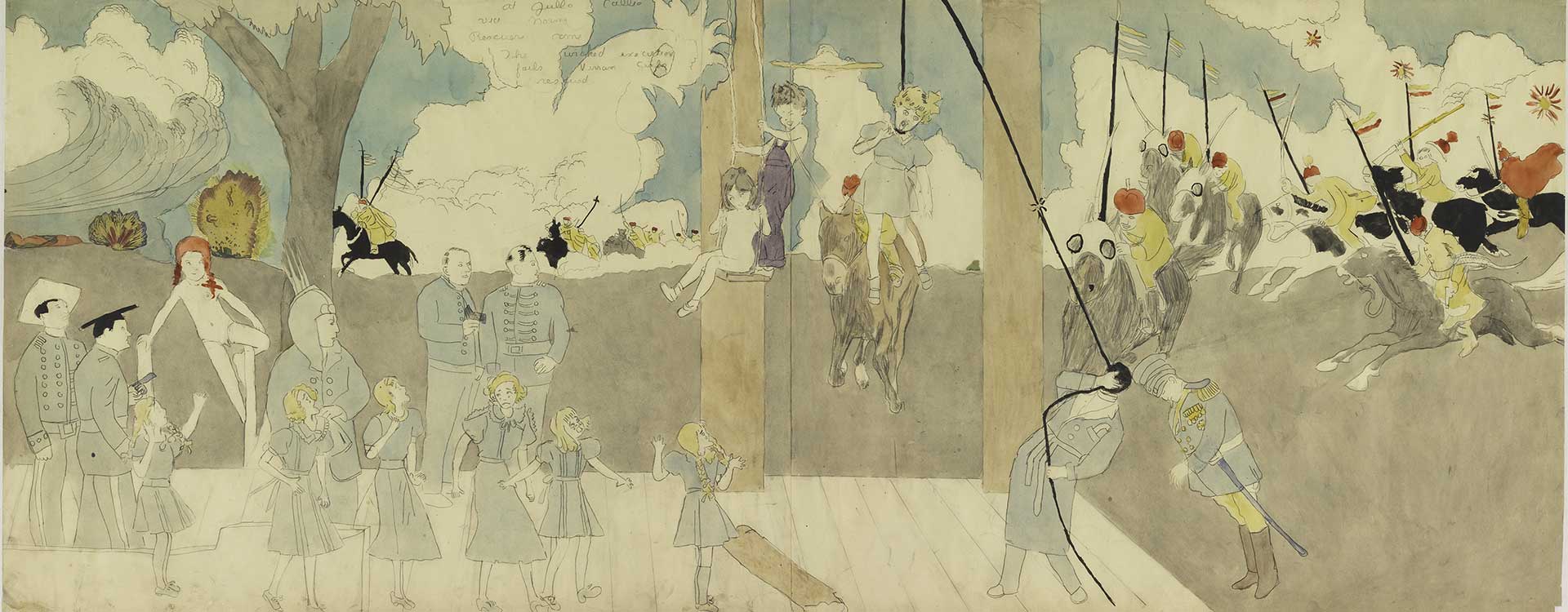
A journey into the heart of the Henry Darger mystery, through virtual reality
It is a small room, on the top floor of a brick building at 851 Webster Avenue, in Chicago. Near a window, a desk overflows with jars of paint, pencils, torn or cut-out papers, and stacks of magazines. In one corner, an old typewriter. On the grimy walls, photographs of child star Shirley Temple and yellowed press clippings sit alongside images of the Virgin Mary. The wallpaper peels from the ceiling, and the lighting consists of bare bulbs. It is here, in the secrecy of his den, that a man named Henry Darger patiently constructed, over more than forty years, an entire universe of his own.
By day, Henry Darger worked as a janitor in a nearby hospital; by night, he would tirelessly cut out images he had gathered from the streets amid the debris, tracing and painting them in watercolour.
By day, Henry Darger worked as a janitor in a nearby hospital; by night, he would tirelessly cut out images he had gathered from the streets amid the debris, tracing and painting them in watercolour. A reserved man who shunned all social contact, he was known to have no friends. In 1972, already in his eighties and in failing health, he was moved to a care facility. His landlords, photographer Nathan Lerner and his wife Kiyoko, decided to have the apartment cleaned out—and were utterly stunned by what they found.
There, accumulated over decades, they discovered dozens of large narrative panels in vivid colours, along with mysterious manuscripts, including an autobiography titled History of My Life and a typewritten novel of over fifteen thousand pages. Entitled The Story of the Vivian Girls, in What is Known as the Realms of the Unreal, of the Glandeco-Angelinian War Storm Caused by the Child Slave Rebellion, this epic tale mirrors Darger’s painted work. It recounts the harrowing adventures of seven sisters, the “Vivian Girls”, young enslaved girls who fight back against monstrously violent adults. A story of apocalypse, both naïve and profound, it draws deeply from the traumas of Darger’s childhood.
Do you believe it, unlike most children I hated to see the day come where I would be grown up. I never wanted to. I wished to be young always. I am grown up now and an old, lame man, darn it.
Henry Darger in his autobiography
A reading of Darger’s five-thousand-page autobiography reveals his tragic life story: born in 1892 in Chicago’s impoverished neighbourhoods, he lost his mother early on and was separated from his sister. He lived for a time with his alcoholic father before being placed in the Lincoln Asylum, a psychiatric institution notorious for its harsh conditions. There, he endured repeated abuse. As a teenager, he managed to escape, walking nearly a hundred kilometres alone, before settling in Chicago. In 1932, he moved into 851 Webster Avenue—a place he would quietly inhabit for over forty years.
In 1973, Henry Darger passed away, leaving behind neither descendants nor family. His former landlords, Nathan and Kiyoko Lerner, took it upon themselves to bring the phenomenal work of this self-taught artist—who had lived entirely on the margins—into the public eye. A true outsider in every sense (in English, ‘outsider art’ refers to art brut).
In 1979, “Outsiders”, the first exhibition to feature Darger’s work, was held at the Hayward Gallery in London. The artist’s dark and unsettling universe captivated audiences. During the 1990s and 2000s, interest in art brut grew steadily, and major exhibitions were dedicated to Henry Darger. The first in Paris was held in 2006 at La Maison Rouge, followed by a 2015 monographic exhibition at the Musée d’Art Moderne, showcasing an exceptional donation of forty-five works made by Kiyoko Lerner in 2012–2013.
Having died in complete anonymity, Henry Darger is now one of the most renowned figures in outsider art, some of his works fetching prices nearing eight hundred thousand dollars.
Having died in complete anonymity, Henry Darger is now one of the most renowned figures in outsider art, some of his works fetching prices nearing eight hundred thousand dollars. Today, his creations are held in the world’s leading institutions: the Museum of Modern Art, the American Folk Art Museum, and the Whitney Museum of American Art (all in New York); the Collection de l’Art Brut (Lausanne); and the Intuit Art Museum (Chicago), which holds the largest collection of objects that belonged to the artist.
The Centre Pompidou holds no fewer than six painted panels in its collection, executed between 1950 and 1960 and donated to the Musée National d’Art Moderne in 2021 by art brut collector Bruno Decharme. These works are currently on display in the exhibition “Art brut. The intimate workings of a collection”, presented at the Grand Palais in co-production with the Centre Pompidou.
To extend the experience, Insider-Outsider, a ground-breaking virtual reality installation (headset equipped), invites visitors to immerse themselves in the artist’s dreamlike and sombre world. This innovative and poetic project was born from the imagination of a man deeply devoted to Darger: Philippe Cohen Solal.
It was somewhat by chance that the musician—known in particular for his multi-platinum Gotan Project (2001)—first encountered Darger’s work in the early 2000s, during a visit to the American Folk Art Museum in New York. The very next day, Cohen Solal met Kiyoko Lerner. From that pivotal moment onwards, he became utterly fascinated by the artist, whose universe has nourished him both musically and intellectually. “I feel an almost personal connection to this artist, someone I identify with in many ways: like him, I’m self-taught, and like him, I create imaginary worlds,” the musician explains. “Darger draws from all corners of popular culture, from comic books to the film The Wizard of Oz and Lewis Carroll’s Alice in Wonderland, which was a major source of inspiration. He cuts, pastes, redraws—in other words, he samples, much like a musician … Had he been born into a different milieu, who knows? He might have become a kind of Warhol.”
Darger draws from all corners of popular culture, from comic books to the film The Wizard of Oz and Lewis Carroll’s Alice in Wonderland, which was a major source of inspiration. He cuts, pastes, redraws—in other words, he samples, much like a musician.
Philippe Cohen Solal
In 2021, Cohen Solal released Outsider, a pop concept album (composed with Mike Lindsay) based on song lyrics found in Darger’s writings. He also produced a seven-episode podcast retracing the journey of the reclusive artist, with actor Denis Lavant lending his voice to Darger.
For Cohen Solal, the VR experience Insider-Outsider marks the closing of a chapter. “It feels like an extension of my previous work,” the musician explains. Not initially a fan of 3D projects, he nonetheless threw himself into it wholeheartedly: “What interests me here is not so much virtual reality, but virtual unreality. This isn’t a documentary project—it’s an imaginary one.” For nearly a year, Cohen Solal worked closely with the teams at Lucid Realities, a company specialising in immersive and interactive experiences (already behind “Van Gogh’s Palette” for the Musée d’Orsay and “Dance Dance Dance – Matisse” for the Musée d’Art Moderne de Paris).
Insider-Outsider invites participants to immerse themselves in the fantastical and unsettling world of the Vivian Girls—warrior children battling the cruelty of the world, braving storms and tornadoes. It is a musical and participatory journey, a space-time odyssey inhabited by hybrid creatures. The starting point of this voyage is Darger’s room, “the matrix of his work, his laboratory”, as Cohen Solal describes it. The reconstruction of this space is based on extensive documentary research, drawing from photographic sources and numerous eyewitness accounts, and was carried out by set designer Jérôme Clermont of Atelier Obermant.
If Darger were alive today, perhaps he would have been drawn to virtual reality—after all, it’s a tool for creating a world.
Philippe Cohen Solal
What would Darger have thought? Philippe Cohen Solal: “If Darger were alive today, perhaps he would have been drawn to virtual reality—after all, it’s a tool for creating a world … The reason his work is so powerful is that it profoundly questions what it means to be an artist. Being in a museum or universally recognised doesn’t necessarily make someone an artist. Today, we live in such a narcissistic world, where even artists are caught in a constant quest for validation. Outsider artists like Henry Darger create out of necessity—their very lives depend on it.” ◼
Related articles
In the calendar
Henry Darger, « At Julio Callio vice norma rescuers come the wicked execution... » (1950 - 1960)
Donation Bruno Decharme, 2021
© Centre Pompidou/Dist. GrandPalaisRmn
